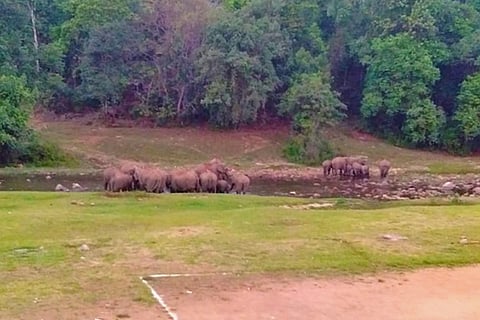

“They are coming, let’s get out of their way,” hollered a boy as he and his friends were playing cricket on a playground in Anakkulam, a small hamlet in Idukki district. The sprawling playground is situated right across a dense forest, separated only by a thin stream of water. As the boys peacefully dispersed from the playground, a herd of elephants appeared from the thicket in the evening. And soon, elephants started drinking water using their trunks.
Anakulam, or elephant’s pond in Malayalam, is situated around 40 kilometres from the popular hill station Munnar. According to the natives, wild elephants and their claves from the forests under the Malayattoor forest division frequently arrive at the Anakulam river to drink water in the evening. And what really attracts these jumbos to this river are the water bubbles that have a particular salty flavour.
Incidentally, Idukki district is a high-range, situated more than 5,000 feet above sea level. So then what makes the water salty remains a mystery even to the officials, says Nagaraj BN, former Divisional Forest Officer and current Estate officer, Forest Head Quarters, Thiruvananthapuram.
“The mineral content in the water is the prime attraction for the wild elephants. We tested water samples from the river and found traces of salt content. We believe the mineral-rich water seeps through the rocks on the riverbed,” explains Nagaraj.
But there is another factor that makes the arrival of these elephants so unique. “Generally, elephants bathe in any water. But the wild elephants do not take a bath in the Anakulam river; they use it only to drink water,” says Nagaraj, adding, “They are somehow aware that the water from this stream is used only for drinking.”
Once they reach here, the elephants stay back on the banks of the river for at least six to seven hours, or even until the following day, before retreating to the forest. “When one herd leaves, another herd trudges to the bank to drink the water,” adds Nagaraj.
How natives and elephants live in harmony here
As per the available data, elephants have been coming to the river since 1912, says Nagaraj. Although the town is situated close to this river, natives say that this has not caused any disturbance.
“The elephants do not enter the human territory when they come here and we don’t disturb the elephants. We at times ask the tourists also to do the same,” says Albin Joshi, a native who runs a night shop near the river.
Prince MD, who runs a homestay in Anakkulam, says that tourists throng to see these wild elephant herds. “Some tourists book rooms specifying they wanted to see the elephants drinking water,” he adds.
Ousepachan, who runs a tea shop in Anakkulam, however, says it is rare that the tuskers cross the border and destroy shops and crops. “Whenever such incidents do take place, we usually do not take seriously," he said.
Sunny Mathew, who works in Dubai, comes to Anakulam whenever he visits Kerala. “I once spotted a herd of 31 elephants once. Earlier, I have only heard of these elephants but was excited to watch them closely,” he tells TNM.
On one hand, as Anakulam is emerging as one of the popular destinations for tourists, sometimes it is a challenge for the natives. “Currently, these elephants do not pose a threat to us. But tourists, at times, try to provoke them. They try to flash headlights during night rides to get a better view of these elephants. We fear such actions will provoke the tuskers and turn them violent. If we do not bother these animals, they will not attack us; else, we will have to face the dire consequences,” said a native, who did not wish to be named.
To prevent elephant breach into human habitations and the farmlands, the Mankulam Forest Division had set up a 1.2 km crash guard rope fencing on the riverside from Anakulam to Valiyaparakkuty. The fencing was constructed on a pilot basis and is being tested by IIT Palakkad.
The crash guard rope fencing, Forest official Nagaraj says, will be an alternative to options such as an elephant-proof wall, rail fence, stone pitched trenches, steel fencing and solar fencing. “Crash guard rope fencing is the most effective way to prevent the tusker menace as it will not harm the animals in any way,” he added.